Have you ever dreamed of a place where the mountains are so tall they almost touch the sky, where the air is fresh and clean, and everything around you feels calm and peaceful. That place is Ladakh, a beautiful and remote region in the far north of India.
Ladakh is known as the “Roof of India” and the “Land of High Passes.” The name “Ladakh” comes from two words: “La,” meaning mountain pass, and “Dhak,” meaning land. So, Ladakh means the “land of mountain passes,” and you’ll see many of them as you travel through the region.
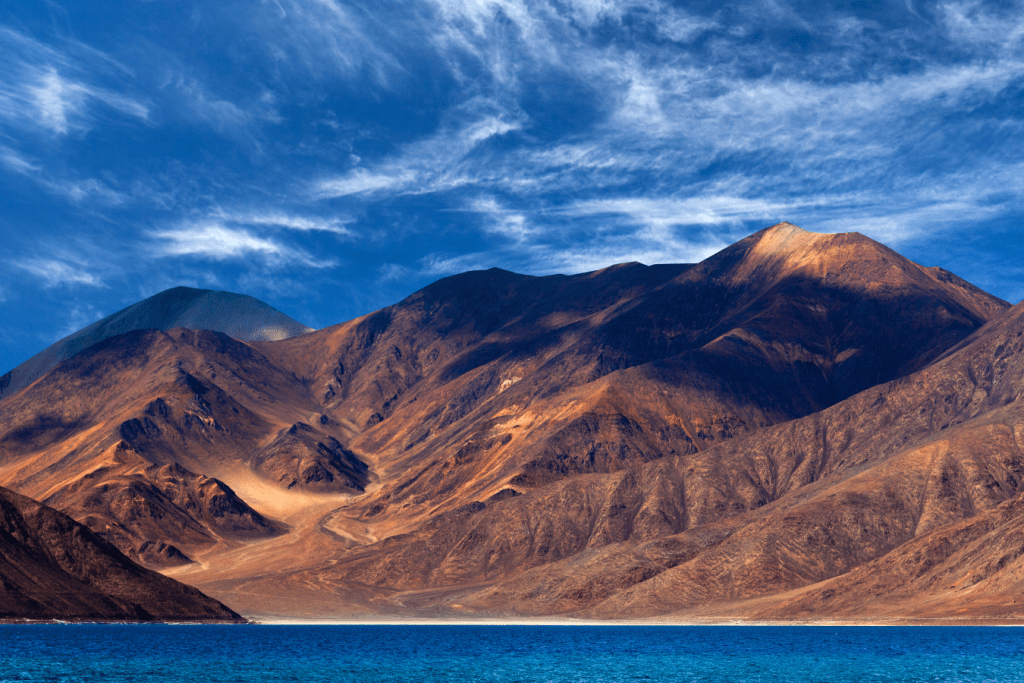
This area is surrounded by the huge Himalayas and Karakoram mountain ranges. It is one of the highest places where people live in the world. While cities like Delhi or Mumbai are just a few hundred meters above sea level, Ladakh is more than 3,000 meters high. Some places, like Khardung La Pass, go over 5,000 meters, making it one of the highest roads you can drive on.
Because it’s so high, Ladakh feels different from anywhere else. You’ll see deserts, bright blue lakes, snow-covered peaks, and old monasteries in the middle of nowhere. Life here is slow and peaceful, and also be everything is connected to nature.
If you’re planning a trip to Ladakh, you may have questions: When is the best time to visit? How long should you stay? What are the must-see places? And, is it safe for families or solo travelers?
This guide will help you find all the answers and give you all the information you need to plan.
Best Time to Visit Ladakh
The best time to visit Ladakh is from May to September, when the weather is sunny and all the popular places are open. It’s great for sightseeing and outdoor activities. If you love snow and adventure, winter offers the Chadar Trek, but it’s very cold and services are limited.
| Season | Best For | Weather | Temperature | Highlights | Tips |
| Summer (May to September) | Most travelers, families, first-time visitors | Dry, sunny, clear skies | 10-15°C | All major roads open, great for sightseeing, photography, cultural festivals | Best time for comfort; acclimatize to high altitude |
| Winter (November to February) | Adventure seekers, snow lovers | Extremely cold, snowy | Below -20°C | Chadar Trek, peaceful surroundings, snow-covered mountains | Be prepared for isolation and freezing temperatures |
| Monsoon (Late July to August) | Travelers looking for quieter trips | Rain on the roads to Ladakh, some landslides | Mild (varies) | Ladakh itself is dry, but roads may be blocked due to landslides | Avoid if on a tight schedule; expect delays |
Best Places to Visit in Ladakh: Unveil the Hidden Treasures
Ladakh, a land of surreal landscapes and vibrant culture, offers a unique blend of adventure, peace, and history. From breathtaking monasteries to serene lakes, each destination in Ladakh has its own charm.
1. Pangong Lake: The Blue Jewel of Ladakh
Pangong Lake is one of the most famous and beautiful places in Ladakh. It is known for its bright blue color that changes throughout the day — sometimes it looks dark blue, sometimes light, and sometimes even green. The lake is very high up in the mountains, so about 4,350 meters above sea level, and stretches over 130 kilometers, with part of it going into China.
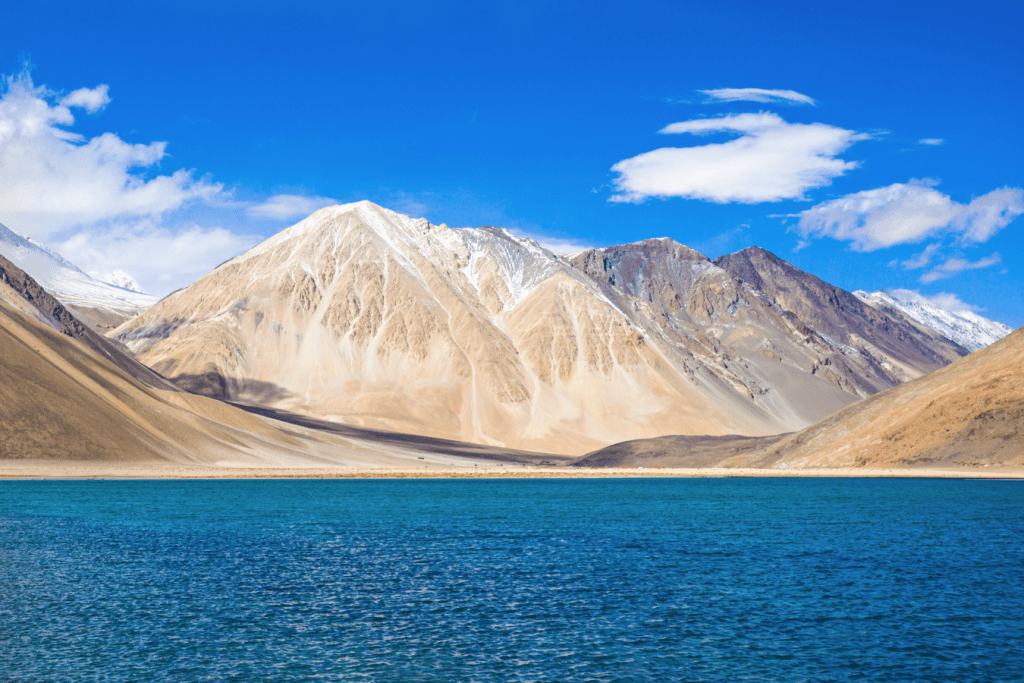
The view here is peaceful and quiet. You can walk by the lake, take amazing photos, or just sit and enjoy the calm. At night, the stars shine brightly, and so many people love camping here under the sky.
If you love nature, peaceful places, and beautiful views, Pangong Lake is a must-visit.
Sightseeing & Activities: Enjoy a peaceful boat ride on the lake, or simply walk along its shores while soaking in the stunning mountain views. It’s also an excellent spot for camping and stargazing under the clear skies.
Best Food Experience: Don’t miss tasting local dishes like Thukpa (noodle soup) and Momos (dumplings) from the small eateries near the lake.
2. Nubra Valley: A Desert in the Middle of Snowy Mountains
Nubra Valley is one of the most surprising places in Ladakh. Imagine golden sand dunes, just like a desert — but surrounded by tall snowy mountains! That’s what makes Nubra so special. You can even ride a rare double-humped camel here, known as the Bactrian camel.
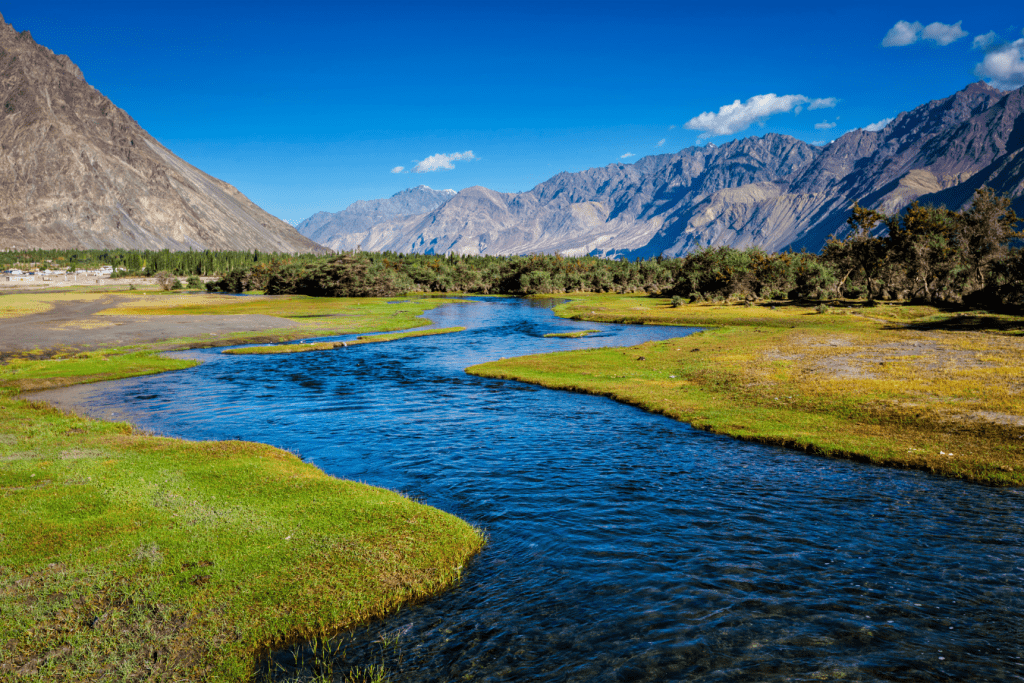
But there’s more than just sand and camels. Nubra is full of peaceful monasteries, like the famous Diskit Monastery with its giant Buddha statue watching over the valley. The air is fresh, the people are warm, and the views are unforgettable.
Sightseeing & Activities:
Walk through ancient monasteries, enjoy a camel ride across the dunes, or go biking and trekking in the cool mountain air. Nubra is perfect for adventure, relaxation, and exploring something truly unique.
Best Food Experience: Try the Ladakhi Tsampa (roasted barley flour) or sample fresh Yak milk products.
3. Leh Palace: A Step Back in Time
Leh Palace is like a window into the royal history of Ladakh. Built in the 1600s, this nine-storey palace stands tall on a hill, quietly watching over the town of Leh. From the top, you get breathtaking views of the entire city and the mountains beyond — a perfect mix of history and nature.
Walking through the old wooden corridors and stone walls, you can almost feel what life was like for Ladakhi kings and queens. It’s peaceful, a little mysterious, and also full of stories from the past.
Sightseeing & Activities:
Climb up to the palace for amazing views, also explore the quiet rooms filled with old paintings and artifacts, and snap some beautiful photos along the way.
Best Food Experience: Head to the local cafes in Leh town to enjoy a cup of Kahwa (traditional Kashmiri tea) and a slice of freshly baked bread.
4. Tso Moriri Lake: Tranquility at its Best
Tso Moriri is a calm and peaceful lake hidden high up in the mountains, far from the crowds. Located in the quiet Changthang Plateau, it feels like nature’s secret spot — quiet, untouched, and full of beauty. The deep blue water surrounded by snowy peaks creates a picture that stays in your memory forever.
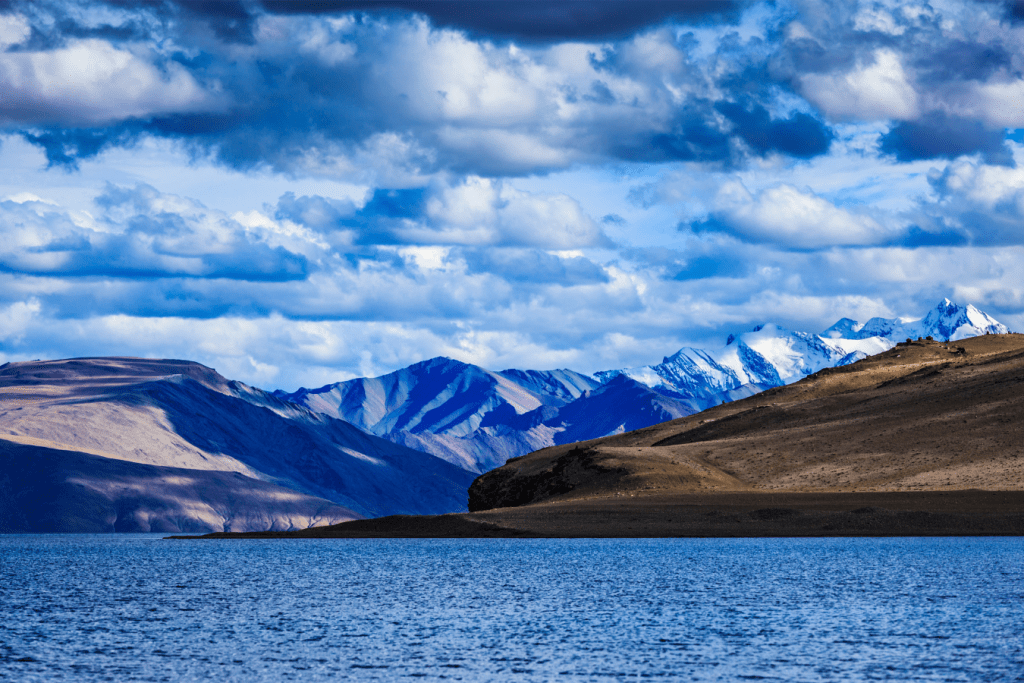
This lake is perfect for travelers who want to slow down, breathe in the fresh air, and enjoy the silence. Unlike the more popular Pangong Lake, Tso Moriri offers peace and solitude, making it ideal for those who love nature and quiet moments.
Sightseeing & Activities:
Walk along the peaceful lakeshore, watch birds flying over the water, or visit small nearby villages where you can meet friendly local people and learn about their traditional nomadic life.
Best Food Experience: For a unique experience, try Chutney made from local wild herbs with your meal in the remote villages around the lake.
5. Magnetic Hill: Defy Gravity
Magnetic Hill is one of those places that makes you rub your eyes in disbelief. Located on the Leh–Kargil highway, this mysterious spot looks like any ordinary road — but here, something strange happens. If you park your vehicle in neutral on a marked spot, it starts rolling uphill all by itself. Or at least, that’s how it seems!
It’s not actually magic — it’s an optical illusion caused by the surrounding slopes and landscape. But when you’re standing there, watching your car move without touching the wheel, it really does feel like Ladakh is full of surprises.
Sightseeing & Activities:
Stop here during your drive, try out the illusion yourself, and take fun videos or photos. It’s a light-hearted and curious break in your journey that adds a bit of wonder to your adventure through Ladakh.
Best Food Experience: Grab a quick snack from the roadside stalls serving fried dough and chai.
6. Hemis Monastery: A Spiritual Haven
Hemis Monastery is a peaceful and powerful place tucked into the hills of Ladakh. It’s the largest and one of the most famous Buddhist monasteries in the region, known not just for its size, but for its deep spiritual vibe and colorful festivals.
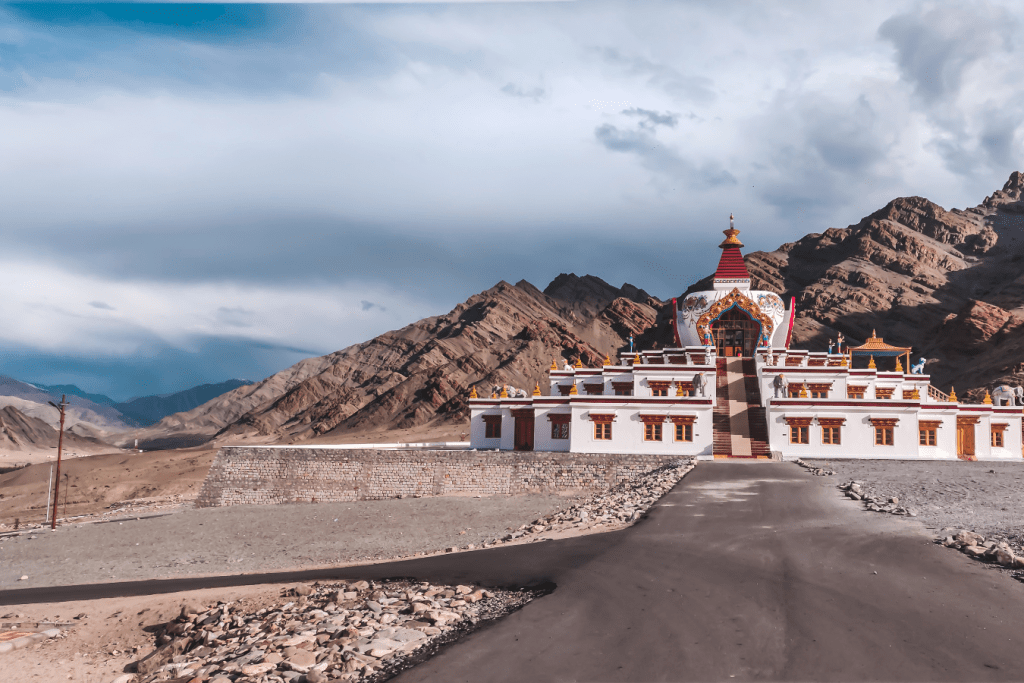
As you walk through its quiet courtyards and ancient halls, you’ll find beautiful wall paintings, sacred statues, and monks chanting softly in the background. If you visit during the Hemis Festival (usually in June or July), the monastery comes alive with music, dance, and people celebrating the birth of Guru Padmasambhava, a key figure in Tibetan Buddhism.
Sightseeing & Activities:
Spend time watching the rituals, admire the giant thangka (religious painting) on display during the festival, and learn about Buddhist culture. The peaceful setting and mountain views around the monastery make it a great stop for both reflection and photography.
Best Food Experience: Try the Ladakhi version of Chhaang (fermented barley drink) while enjoying local steamed dumplings at the monastery’s small eateries.
7. Khardung La: The Gateway to Nubra Valley
Khardung La is not just a mountain pass — it’s a thrilling achievement for anyone traveling in Ladakh. At a height of 5,359 meters (17,582 feet), it ranks among the highest motorable roads in the world, and reaching the top feels like standing on the roof of the Earth.
The journey to Khardung La is an adventure in itself, with winding roads, cold winds, and breathtaking views of rugged mountains and deep valleys. As you climb higher, the air gets thinner, but the excitement grows. It connects Leh to the Nubra Valley and has historic importance, also once being part of the Silk Route.
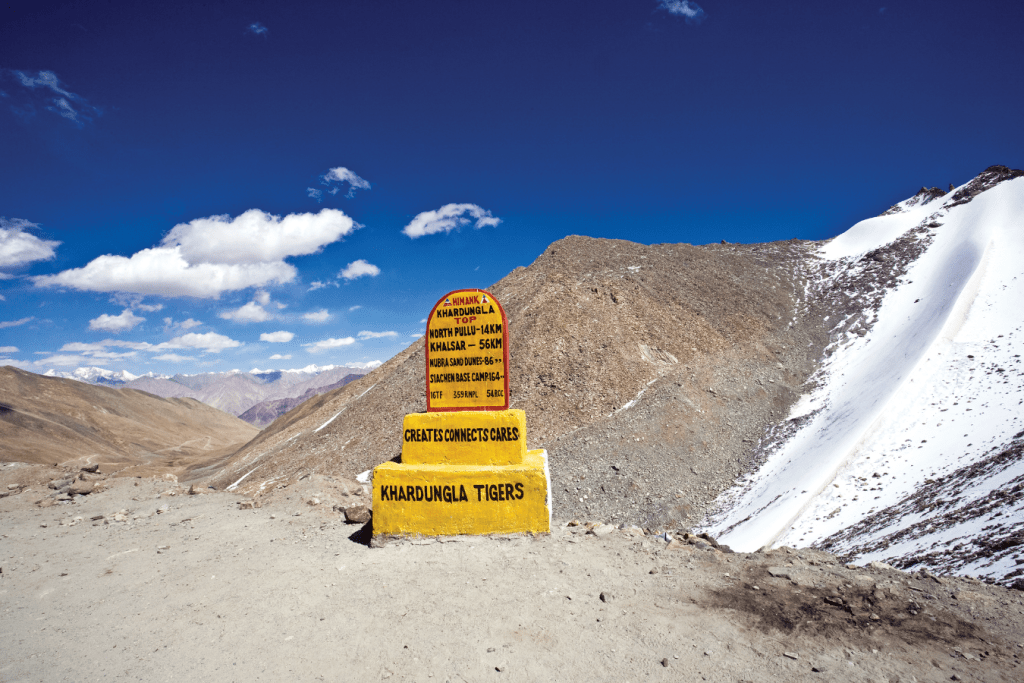
Sightseeing & Activities:
Drive or bike to the top, take photos with the famous Khardung La signboard, and soak in the panoramic views of snow-covered peaks. Don’t forget to pause and breathe slowly — the altitude is extreme, and acclimatization is important.
Best Food Experience: Grab a hot meal from one of the roadside stalls serving noodle soup or roti (flatbread) to warm up after your journey.
Tasting Ladakh: A Warm and Flavorful Food Experience
No trip to Ladakh is complete without savoring its unique and flavorful cuisine. In the cold mountain air, every bite feels extra special — and meals are more than just food, they’re part of the whole Ladakh experience.
Thukpa
This is a hot noodle soup, perfect after a long day in the cold. It has soft noodles, tasty vegetables or meat, and so spicy broth that warms you up from the inside. One spoonful and you’ll feel cozy right away.
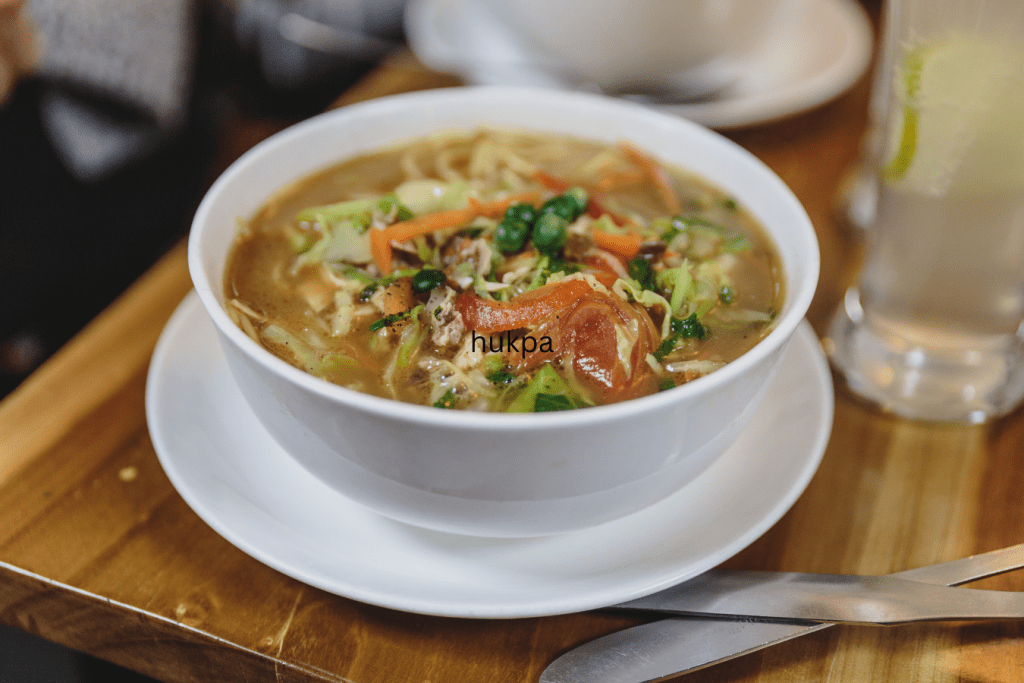
Momos
Ladakhi momos are soft dumplings filled with vegetables or meat. They’re served hot with a spicy red sauce that adds a kick. Eating them fresh and hot is one of the best feelings — simple, tasty, and fun to share.
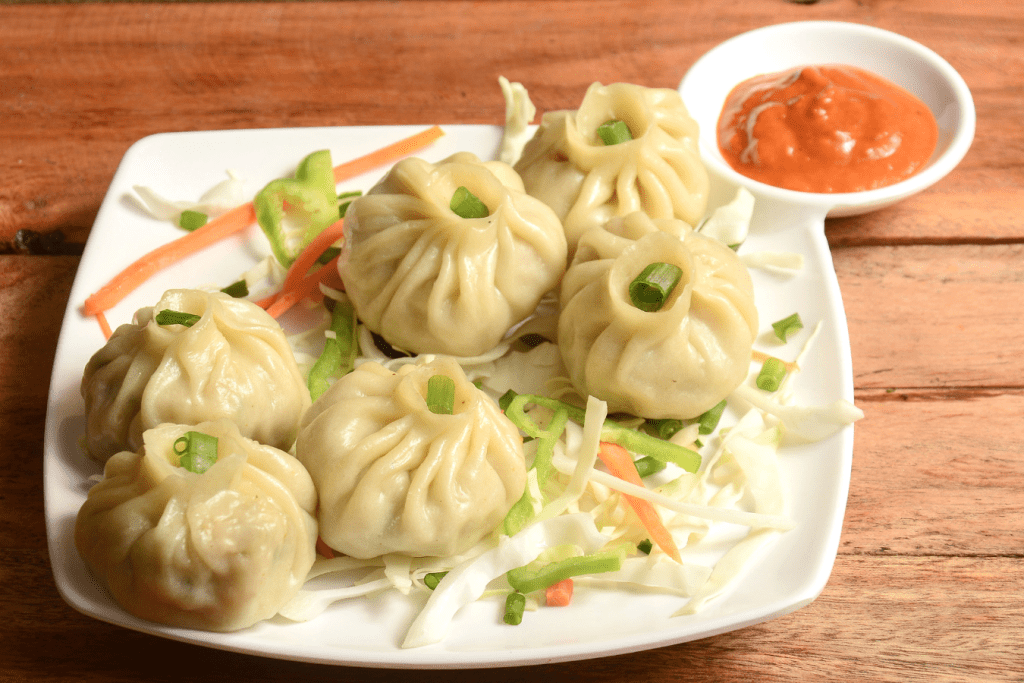
Tsampa
This is a traditional Ladakhi food made from roasted barley flour. It has a nutty taste and is often mixed with butter tea or soup. It’s healthy, filling, and gives you energy in the high mountains.
Chhutney (Wild Herb Chutney)
Made from wild herbs, this chutney is spicy and fresh. It’s full of flavor and goes well with rice or bread. A small bite is enough to wake up your taste buds!
Butter Tea and Yak Cheese
Butter tea (also called Gur Gur Chai) is salty, warm, and creamy. Locals drink it all the time to stay warm. Yak cheese is chewy and strong in flavor — very different, but worth a try!
Trekking in Ladakh
If you love walking through nature, Ladakh is a dream. With its stunning landscapes, peaceful villages, and dramatic mountain views, it’s perfect for trekkers — whether you’re a beginner or a pro.
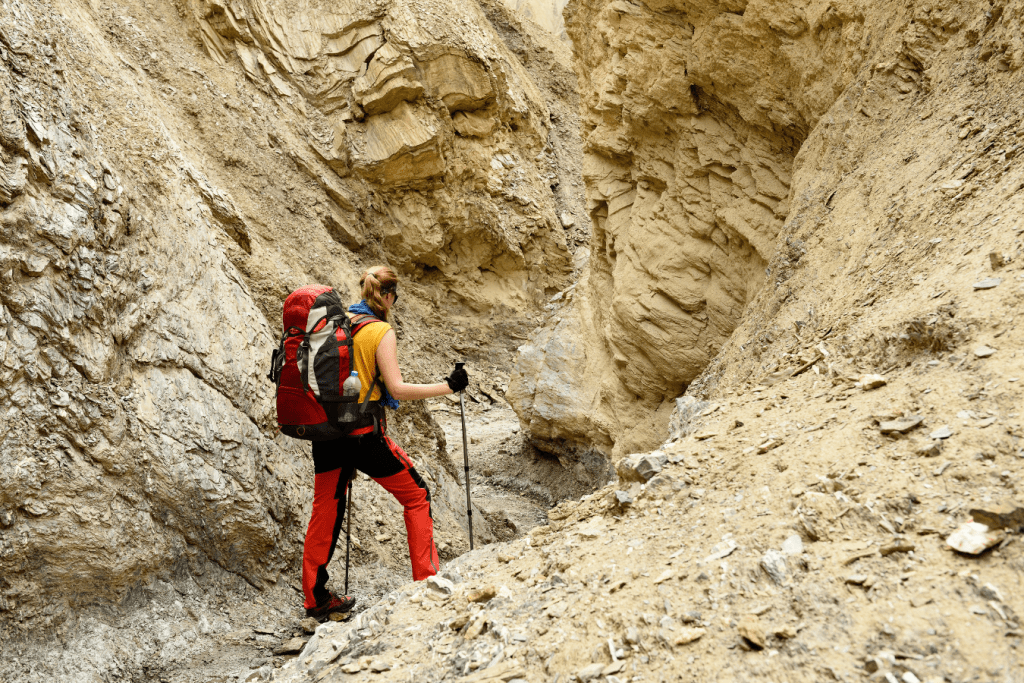
- Sham Valley Trek (Easy): Great for first-timers. It passes through friendly villages and gentle trails, so it’s not too hard on the body.
- Markha Valley Trek (Moderate): A favorite among trekkers. You’ll cross rivers, sleep in village homes, and walk through wide valleys surrounded by peaks.
- Chadar Trek (Challenging): Only for the brave! Done in winter, this trek takes you across the frozen Zanskar River. It’s cold but magical.
- Stok Kangri Expedition: If you’re aiming high — literally — this is a great option. The climb reaches over 6,000 meters and is for experienced trekkers.
Tip:
No matter which trek you choose, it’s best to go with a local guide or trusted tour company. Also, make sure you’re well-acclimatized before starting — altitude sickness is real up here!
How to Reach Ladakh (Leh)?
Getting to Ladakh is half the thrill — whether you fly over the mountains or drive through them. Here’s how you can get there:
By Air (Quickest Way)
- Leh Airport Altitude: ~3,250 m (that’s 10,700 ft — much higher than Delhi at just 216 m or Mumbai at 14 m!)
- Flight Time:
- From Delhi: ~1.5 hours
- From Mumbai: ~3.5 hours (with layovers)
- From Chandigarh or Srinagar: Around 1 hour
- What’s Special?
Flying into Leh feels like landing on the roof of the world. Snowy peaks, rugged valleys — and fresh, thin mountain air from the moment you step off the plane.
Tip: Rest for a day to adjust to the high altitude before exploring!
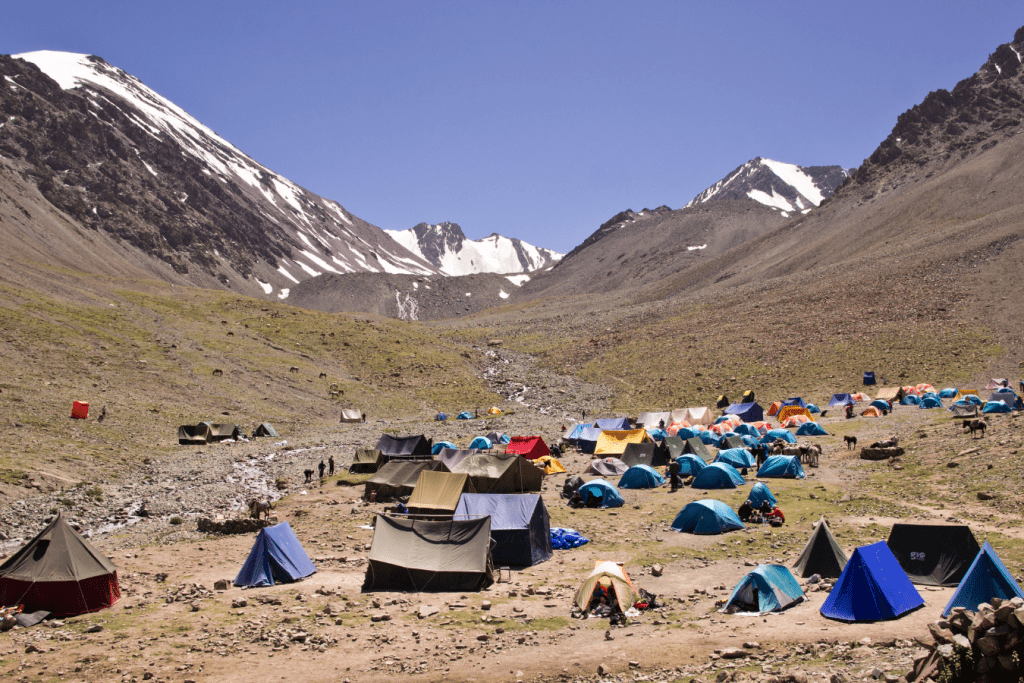
By Road (For the Adventurous Soul)
Two stunning road routes to Leh:
- From Manali – ~480 km
- Time: 2–3 days by bike/car
- Via: Rohtang Pass, Baralacha La, Sarchu
- Highest Point: Tanglang La at 5,328 m — much higher than most Alpine peaks!
- From Srinagar – ~420 km
- Time: 2 days with a night stop (usually in Kargil)
- Via: Sonmarg, Drass, Zoji La, Kargil
- Smoother Ride: Better for first-timers with gradual altitude gain.
Must-Know: These roads are only open between May to October (snow closes the passes in winter).
Buses & Shared Taxis
- Budget-Friendly Option: Govt. and private buses available from Manali/Srinagar.
- Shared Taxis: Faster, but costlier and less comfy.
While your city might sit close to sea level, Ladakh is higher than most mountains you’ve seen on postcards. This journey takes you from the plains straight into the clouds — with every turn revealing something magical.
How Many Days Should You Spend in Ladakh?
Ladakh isn’t just a destination — it’s an experience. And like all great experiences, it takes time. Due to the region’s high altitude, it’s important to go slow and allow your body to adjust. Rushing can lead to altitude sickness and missed moments of beauty.
As a rule of thumb, plan your trip based on how much you want to explore:
- 7 Days: This is the minimum recommended. You can explore Leh, Nubra Valley, and Pangong Lake comfortably. It’s a good starter plan if you’re short on time.
- 10–12 Days: With a few more days, you can also visit Tso Moriri Lake, Alchi Monastery, Lamayuru, and other beautiful villages or monasteries. This option allows for a deeper cultural experience.
- 2 Weeks or More: If you love going off the beaten path, this is for you. You can head to Hanle for stargazing, explore Zanskar Valley, or take on scenic treks like Markha Valley or Sham Valley.
Important Tip:
No matter how long you stay, always spend your first two days in Leh. Why? Because it helps your body acclimatize to the high altitude (around 11,500 ft). Use these days to rest, walk slowly around the town, drink lots of water, and avoid physical exertion.
Essential Travel Tips for Ladakh
Traveling to Ladakh is amazing, but the high altitude and remote areas mean you need to be well-prepared. Here are some key tips to help you stay safe and comfortable:
- First, take it slow. When you arrive, rest for at least 1–2 days to let your body get used to the thin air. This is called acclimatization — and it’s very important.
- Also, drink lots of water. Aim for at least 3 to 4 liters a day. Staying hydrated helps prevent altitude sickness.
- Don’t forget medicines. Bring basics like paracetamol, Diamox (for altitude), and motion sickness tablets. If you have any health issues, consult your doctor before traveling.
- Next, protect yourself from the sun. The sun is strong at high altitudes. Use a good sunscreen, wear sunglasses, and carry lip balm to avoid chapped lips.
- Carry cash. ATMs are only available in Leh, and they may not always work. So, withdraw enough cash before heading to remote areas.
- Lastly, check your mobile network. BSNL and Jio work best in Ladakh. Other networks may not have any signal at all.
Conclusion
To sum it all up, Ladakh is not just a travel destination — it’s an experience that stays with you long after the journey ends. From its snow-capped peaks and turquoise lakes to ancient monasteries and welcoming locals, every corner of Ladakh offers something unique and soul-stirring.
Whether you’re drawn by the thrill of high-altitude adventure, the peace of quiet monasteries, or the simple joy of sipping butter tea while watching the sunset over the mountains — Ladakh delivers all of it, and more. The journey may require some planning and patience, but the rewards are immense.
Moreover, as you’ve seen in this guide, Ladakh suits every type of traveler. You can explore by bike, taxi, or bus.
In the end, traveling through Ladakh teaches you to slow down, breathe deeply, and appreciate the raw beauty of nature — and perhaps even rediscover yourself in the process. So, pack smart, plan thoughtfully, and go with an open heart.